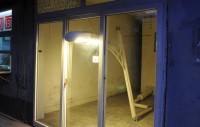HE AN
wind light as a thief
source: leapleapleap
WIND LIGHT AS A THIEF | Arrow Factory, Beijing 2011.07.03-2011.09.20
Summertime is downtime for the gallery system. There are bound to be a few inconsequential group shows, while many galleries just take a vacation, biding time before autumn. Sensing opportunity, He An planned for three separate solo shows to open in Beijing in July. And with this, the strung-out summer period was suddenly injected with a burst of enthusiasm. But is this enthusiasm a case of audience curiosity towards relay-style exhibitions, or just a part of the ripple effect caused by heavy-hitting galleries?
In the consecutive openings of three shows, with such romantic titles as “Wind Light as a Thief,” “I am Curious Yellow, I am Curious Blue,” and “A Mole on Each Breast and Another on the Shoulder,” the discriminatory sensibilities of the contemporary art system were impossible to conceal. Unsurprisingly, the Tang opening was the biggest and best-attended. In comparison with this formidable space in the main strip of 798, the other two exhibitions—one at Arrow Factory, the other at Magician Space—although both with their own objectives, seemed to be cast in mere supporting roles: an overture and an epilogue to the main act. But this may be exactly what He An was thinking, having studiously learned how to play the art world summer game.
For “Wind Light as a Thief,” a towering streetlight was bent and squeezed into the tiny Arrow Factory space, the lamp itself protruding out of the glass door onto the street and fitted with a switch freely operable by passers-by. This switch was wired into a system so that it controlled the lights of an old shop and a streetlamp next to an apartment block nearby. And vice versa: when the switch of any one of these three lights is turned on or off, the other two react accordingly.
In the sudden illumination and extinguishing of these lights, He An engendered a dialogue between complete strangers. But, just like the fallibility alluded to in the exhibition’s title, this dialogue takes the form of disturbance, or, in light of its low intensity, could admittedly be described as interference—no doubt one of the intentions of this humble space nestled in a hutong. Nonetheless the work betrays a certain desire to control. Particularly as the work itself is “hidden” within reality, it becomes not a metaphor of power but instead a conscientious mimicry of the effect of power when wielded. And on opening night, this power reared a somewhat uglier head, arousing the fierce protest of a neighborhood mother and daughter—also the wife and daughter of a well-known artist whose apartment sat right next to the streetlamp—who claimed the lights were a disturbance.
.
.
.
.
.
.
source: arrowfactory
箭厂空间荣幸地推出北京艺术家何岸的互动装置作品《风轻似小偷》。在这件作品中,切换开关这一简单无奇的动作被放大为对于光、黑暗和未知之物的显现与玩味。展览空间中放置着一盏路灯,观众通过一个开关可以对它进行控制,但除此之外这个开关还控制着五百米外一家店铺里以及附近某处公共场所的另两盏灯。这三盏灯都装置了独立的开关,何岸通过一种特殊的方式将它们连接在一起, 试图提示种种可见和不可见间的联系。观众将跨越公共和私密空间的界线,成为一场只为参与者所知秘密游戏的同谋。作品的标题“风轻似小偷”源于尼克·凯夫(Nick Cave)一张专辑中的歌词。
何岸1970年生于武汉。他的装置和影像作品探讨了社会空间的种种特质。何岸毕业于湖北美术学院,作品曾在英国泰特利物浦美术馆,北京尤仑斯当代艺术中心,上海多伦现代美术馆以及北京魔金石空间展出。目前他在北京生活和工作。


